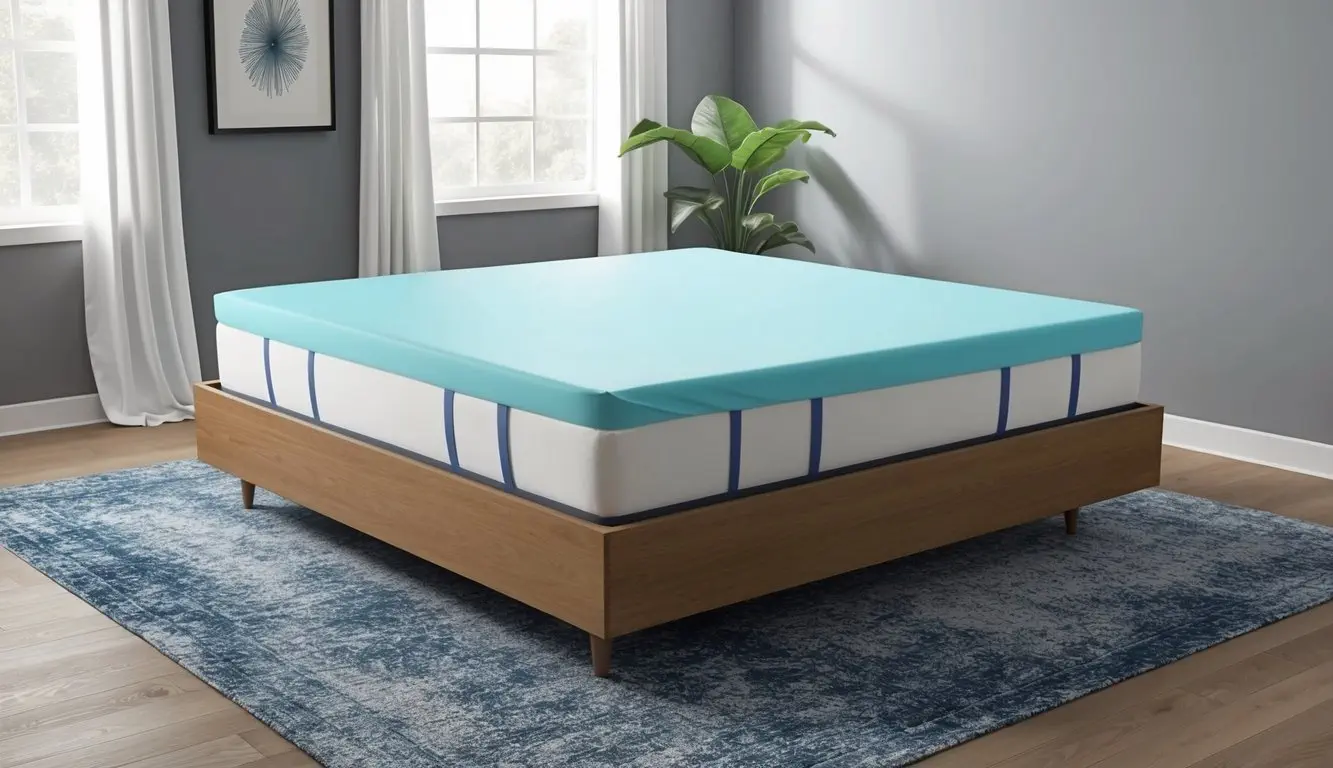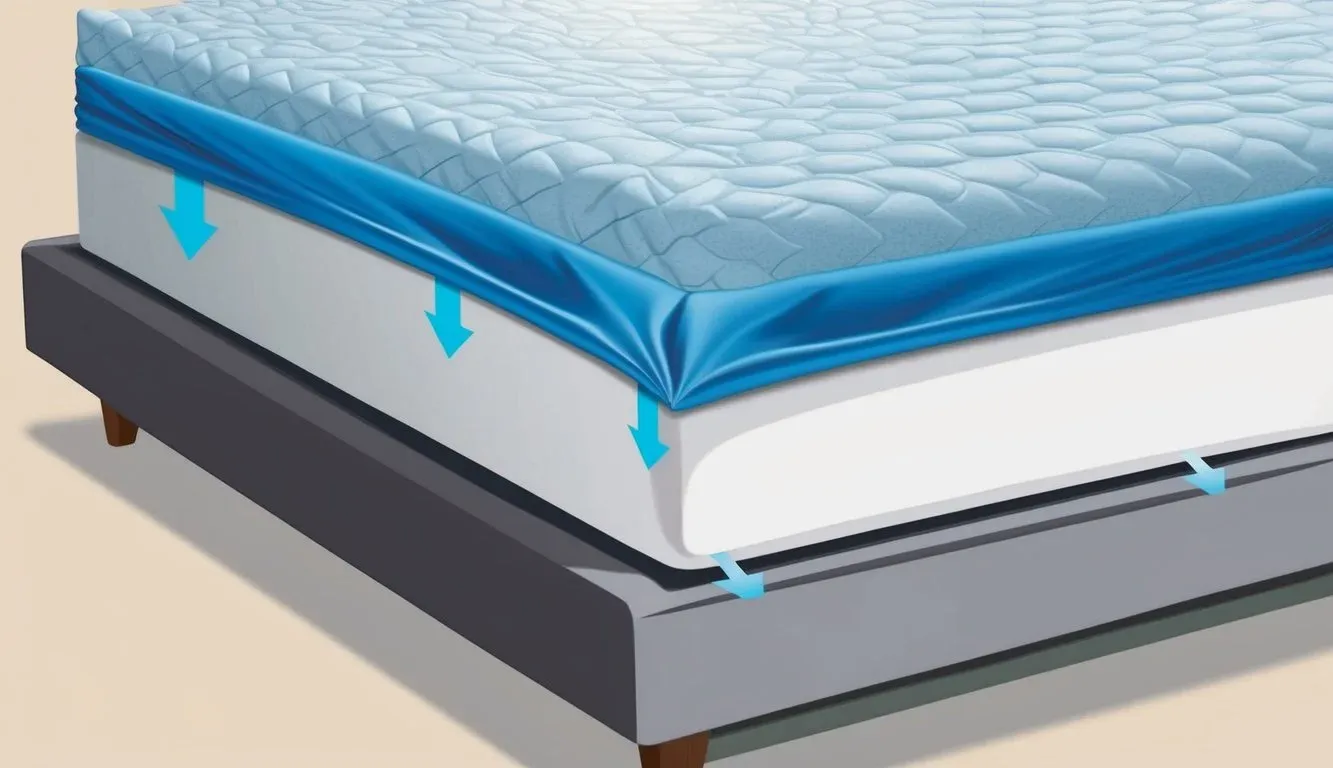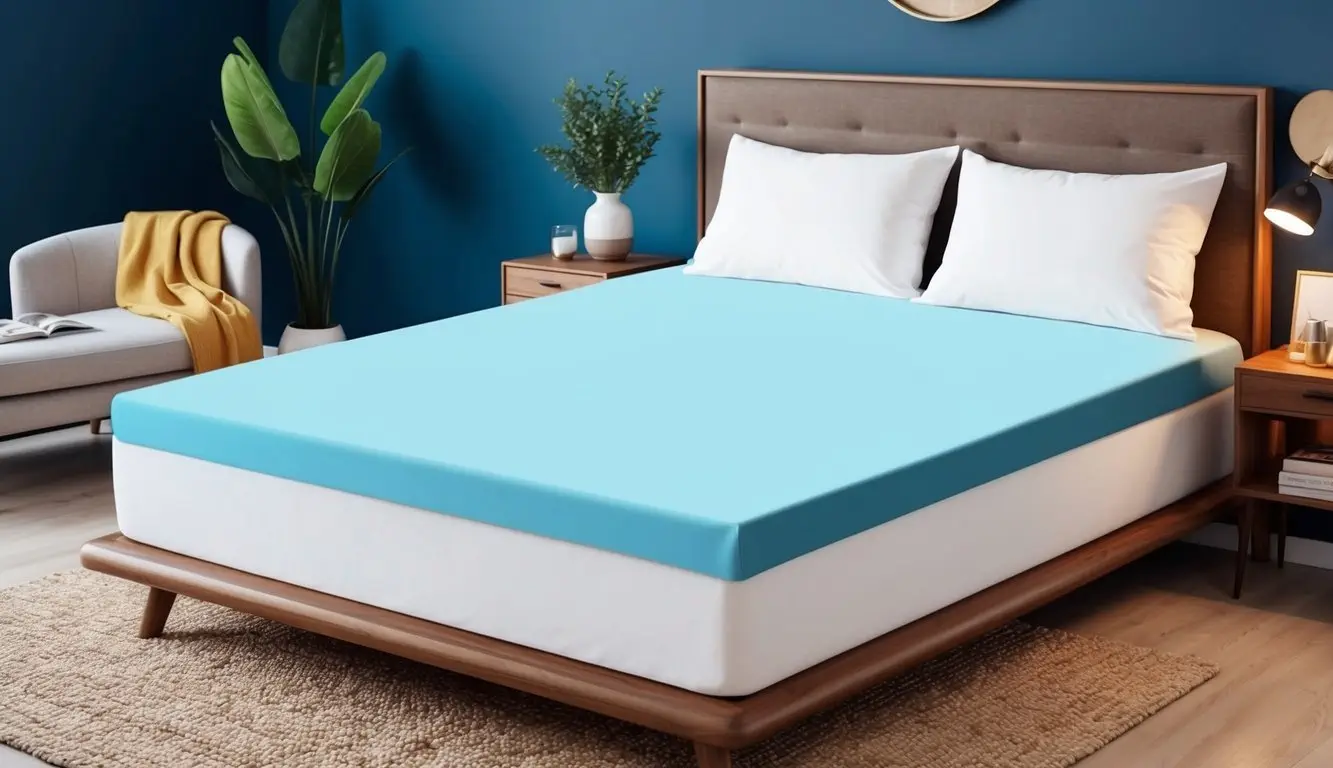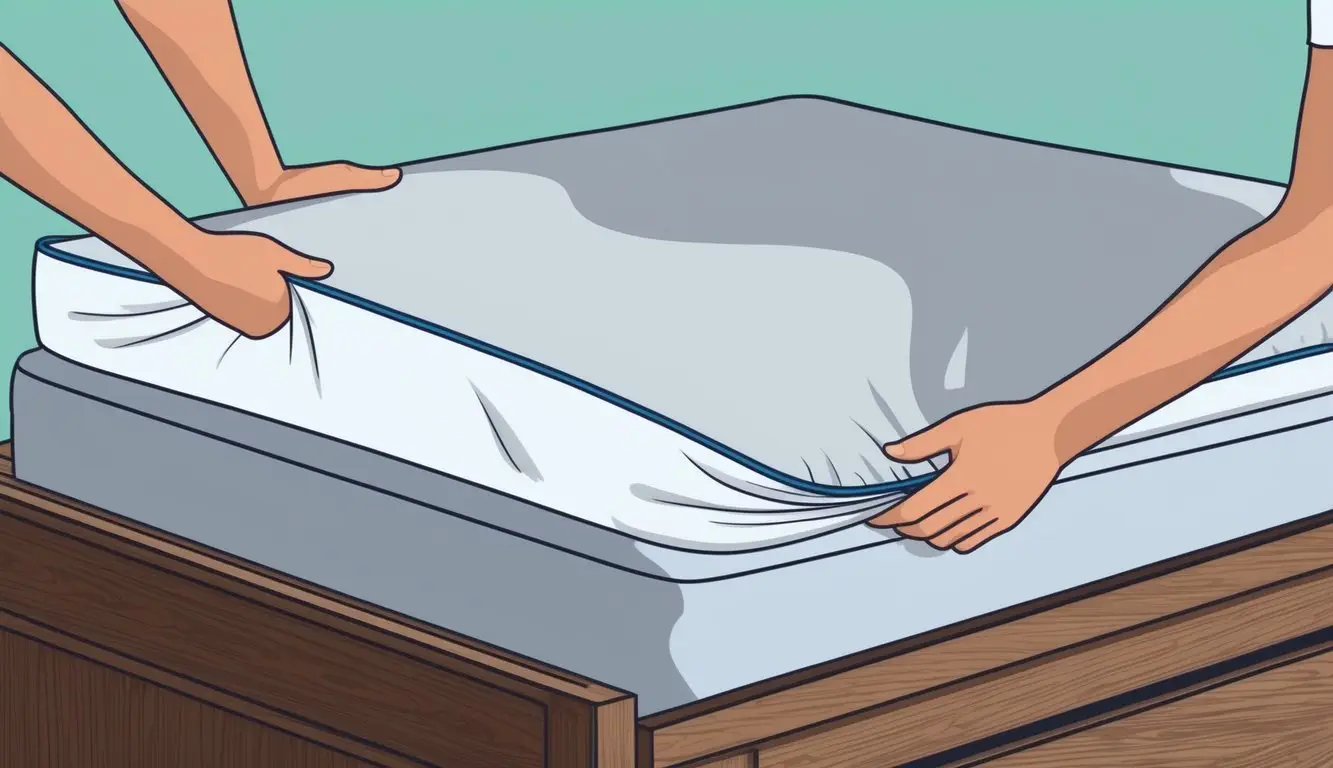A mattress protector is a removable bedding item that covers and shields your mattress from spills, stains, allergens, and wear. It fits over your mattress like a fitted sheet or completely encases it for total protection.

Investing in a quality mattress protector offers both comfort and peace of mind for any bed owner. The protective layer helps extend the life of your mattress by preventing damage from accidents and daily use, while also creating a barrier against dust mites and other allergens that can affect sleep quality.
Many people don’t realize that most mattress warranties become void if the mattress becomes stained. A protector provides an affordable way to safeguard this significant investment while maintaining a clean, hygienic sleeping environment that feels just as comfortable as sleeping directly on the mattress.
What Is a Mattress Protector

Mattress protectors serve as essential bedding accessories that shield your mattress from various hazards while extending its lifespan. They provide a defensive barrier against spills, allergens, and pests that might otherwise damage your mattress or compromise your sleep quality.
Definition and Purpose
A mattress protector is a removable bedding item designed to encase part or all of your mattress. Its primary purpose is to create a protective barrier between your body and the mattress. This barrier defends against liquids, dust mites, allergens, and bed bugs that could otherwise penetrate your mattress.
Mattress protectors help extend the life of your mattress by preventing stains that might void warranties. They also create a more hygienic sleeping environment by blocking sweat, body oils, and dead skin cells from reaching your mattress.
For allergy sufferers, a quality mattress protector can reduce exposure to common triggers like dust mites and pet dander. Many modern protectors accomplish this while remaining virtually undetectable beneath your sheets.
Varieties of Mattress Protectors
Mattress protectors come in several forms to suit different needs. Fitted protectors work like fitted sheets, covering the top and sides of the mattress. Encasement protectors completely surround the mattress with a secure zipper closure for maximum protection against bed bugs.
Materials vary widely among protectors. Common options include:
- Cotton: Breathable and natural feeling
- Polyester: Durable and often less expensive
- Bamboo: Eco-friendly with natural cooling properties
- Certified organic materials for environmentally conscious consumers
Waterproof mattress protectors feature a special membrane that blocks liquids while allowing air to circulate. These typically use materials like polyurethane or vinyl for the waterproof layer.
Some specialized protectors offer cooling technology, noise reduction, or added padding for comfort.
How Mattress Protectors Work
Mattress protectors employ specialized construction to provide their protective benefits. The top layer usually consists of a comfortable fabric like cotton, polyester, or bamboo that feels soft against sheets. Beneath this lies the functional barrier.
For waterproof mattress protectors, a thin waterproof layer blocks liquids from passing through while remaining breathable. This technology prevents spills from reaching the mattress while allowing heat and moisture vapor to escape, preventing the clammy feeling of older plastic covers.
Bed bug mattress protectors work through tight weaves and secure closures. The fabric’s pore size is specifically designed to be smaller than bed bugs, preventing their entry or escape. The secure zipper closure ensures complete protection by sealing off all potential entry points.
Most quality protectors are machine washable, making maintenance simple. Regular washing removes allergens and keeps the protector functioning properly.
Benefits of Using a Mattress Protector

A mattress protector offers several important advantages that help preserve your investment and improve your sleep environment. These protective covers serve multiple functions beyond basic mattress care.
Protection Against Spills and Stains
Waterproof mattress protectors create a reliable barrier against liquid accidents. They prevent spills from coffee, water, and other beverages from seeping into your mattress.
Most quality protectors use waterproof materials that block liquids while remaining breathable. This technology allows air to circulate while keeping moisture out.
Children and pets make spills more likely in many households. A good protector saves you from permanent stains and the unpleasant odors that develop when liquids soak into mattress materials.
Cleaning becomes much simpler with a protector in place. Instead of struggling to clean your entire mattress, you can simply remove and wash the protector according to manufacturer instructions.
Allergen and Dust Mite Barrier
Mattress protectors significantly reduce exposure to common allergens. They block dust mites, pet dander, and pollen that would otherwise settle into mattress fibers.
Dust mites thrive in mattresses, feeding on shed skin cells. These microscopic creatures are a leading cause of nighttime allergies and asthma attacks.
People with sensitive skin or respiratory conditions find particular benefit in allergen-blocking protectors. These create a physical barrier between you and potential irritants.
Look for protectors with certifications for allergen protection. These have been tested to ensure they actually prevent allergen particles from passing through their material.
Extending Mattress Lifespan
A quality mattress represents a significant investment. Protectors help preserve this investment by preventing common forms of damage and wear.
Body oils and sweat naturally transfer to your mattress during sleep. Over time, these fluids break down mattress materials and can void manufacturer warranties.
Mattress protectors prevent the buildup of dead skin cells. An average person sheds nearly a pound of skin cells yearly, much of which would otherwise end up in your mattress.
Using a protector can add years to your mattress lifespan. This makes the small cost of a protector an excellent value compared to early mattress replacement.
Bed Bug Prevention
Bed bug mattress protectors feature special construction techniques that prevent these pests from entering or escaping your mattress. They typically encase the entire mattress with secure zippers.
These specialized protectors help during active infestations by trapping any bugs already in the mattress. This prevents them from feeding and eventually leads to their death.
For prevention, encasement-style protectors block bed bugs from establishing colonies in your mattress. This provides peace of mind, especially when traveling frequently or living in multi-unit buildings.
Quality bed bug protectors undergo testing to ensure effectiveness. Look for products specifically labeled for bed bug protection rather than standard protectors if this is your primary concern.
Choosing the Right Mattress Protector

Finding the perfect mattress protector requires considering materials, correct sizing, and key features that match your specific needs.
Material Considerations
Mattress protectors come in various materials, each with distinct benefits. Cotton protectors offer breathability and comfort, making them ideal for hot sleepers. They feel soft against the skin but may not provide complete waterproofing.
Polyester options are typically more affordable and durable. They resist wrinkles and dry quickly after washing. Many budget-friendly protectors use this material as their base.
Bamboo-derived fabrics have gained popularity for their natural cooling properties and eco-friendly credentials. These protectors feel silky and wick moisture effectively.
For waterproofing, look for protectors with a polyurethane layer. This thin, flexible material creates a waterproof barrier without the crinkly noise of plastic. It blocks liquids, dust mites, and allergens while remaining breathable.
Size and Fit for Your Mattress
Proper fit is crucial for effective protection. Measure your mattress height, width, and length before purchasing. Standard mattress depths range from 8-12 inches, but extra thick mattresses may require deep-pocket protectors.
Most protectors use elastic edges that wrap around like a fitted sheet. For complete coverage, consider encasement protectors with zipper closure that cover all six sides of the mattress.
Check the product specifications carefully. Some protectors accommodate mattresses up to 18 inches deep. Ill-fitting protectors bunch up, slide around, and leave portions of your mattress exposed.
The protector should extend fully over your mattress without excessive material that could create uncomfortable wrinkles beneath your sheets.
Feature Checklist
Waterproofing: Essential for protecting against spills, accidents, and bodily fluids. Look for 100% waterproof options with polyurethane backing.
Breathability: Ensures air circulation to prevent heat buildup. Important for comfort during sleep.
Noise level: Lower-quality waterproof protectors sometimes create a crinkly, plastic sound. Premium options remain silent during movement.
Care instructions: Most quality protectors are machine washable. Check temperature recommendations and drying instructions.
Allergen protection: Tight weave fabrics block dust mites, pet dander, and other allergens.
Warranty: Better products offer guarantees ranging from 1-10 years.
Temperature regulation: Some protectors incorporate cooling technologies for hot sleepers or warming features for colder climates.
The protector should fit not just your mattress, but also your lifestyle needs and sleeping preferences.
Care and Maintenance

Proper care of your mattress protector extends its lifespan and maintains its protective qualities. Regular cleaning and careful handling ensure it continues to provide peace of mind against spills, allergens, and wear.
Machine Wash Guidelines
Mattress protectors are designed to be machine washable, making them easy to keep clean. Always check the care label for specific instructions before washing. Most protectors should be washed on a gentle cycle using cold water to prevent damage to the waterproof layer.
Use mild detergents without bleach or harsh chemicals. These can break down the waterproof membrane over time. For stubborn stains, pre-treat the area before washing, but avoid scrubbing aggressively.
Wash your mattress protector every 1-2 months for regular maintenance. If spills occur, clean it immediately to prevent stains or odors from setting in.
Drying and Handling Tips
Proper drying is crucial for maintaining your mattress protector’s waterproof qualities. Tumble dry on low heat or air dry to prevent shrinkage or damage to the protective barriers.
Recommended drying methods:
- Tumble dry on low heat setting
- Air dry flat or hung over a line
- Remove promptly from dryer to prevent wrinkles
Avoid high heat settings, as excessive heat can melt or warp the waterproof layer. Never iron your mattress protector, as this will compromise its waterproof abilities.
When not in use, store your clean mattress protector in a cool, dry place. Fold it loosely rather than cramming it into tight spaces to prevent creases that might crack the protective coating.
Additional Features and Innovations

Modern mattress protectors offer more than just basic protection. Manufacturers have developed advanced features that improve comfort while maintaining functionality.
Temperature Regulation Technology
Today’s premium mattress protectors incorporate innovative cooling technologies to prevent overheating during sleep. Many use phase-change materials that absorb excess body heat and release it when you cool down, maintaining a consistent temperature throughout the night.
Some protectors feature specialized fabrics like Tencel or bamboo that naturally wick moisture away from the body. These materials help regulate temperature by managing humidity and preventing the clammy feeling often associated with waterproof barriers.
Mesh panels and ventilated designs increase airflow between your body and the mattress. This improved circulation prevents heat from becoming trapped beneath you, creating a more comfortable sleeping environment.
For those who sleep particularly hot, cooling gel-infused protectors provide an extra level of temperature control by actively drawing heat away from the body during sleep.
Eco-friendly Options
Environmentally conscious consumers can now choose certified organic mattress protectors made from natural materials. These products typically use organic cotton, wool, or latex that meet strict sustainability standards.
Many eco-friendly protectors avoid harsh chemicals and instead use natural waterproofing methods. Plant-based membranes provide protection without petroleum-derived plastics that can release VOCs (volatile organic compounds).
Biodegradable and recyclable options have emerged as manufacturers respond to environmental concerns. These protectors break down more easily at the end of their useful life or can be processed into new products.
Some companies now offer take-back programs where old protectors can be returned for proper recycling. This reduces landfill waste and completes the sustainability cycle from production to disposal.
Frequently Asked Questions

Mattress protectors serve important functions beyond basic mattress care. They provide protection against various elements while extending mattress life and improving sleep hygiene.
Why should one use a mattress protector?
A mattress protector shields mattresses from spills, stains, and bodily fluids that can penetrate and damage the internal materials. This barrier prevents allergens like dust mites, bed bugs, and mold from accumulating within the mattress.
Protecting a mattress this way preserves its warranty, as many manufacturers void coverage if stains are present. A good protector also extends the usable life of the mattress by years.
For people with allergies or asthma, a protector creates a barrier against common triggers, potentially reducing symptoms and improving sleep quality.
What materials are commonly used in mattress protectors?
Cotton mattress protectors offer breathability and comfort but provide limited waterproofing. They feel natural against the skin and work well in moderate climates.
Polyester protectors are durable and often less expensive than other options. Many blend polyester with other materials for improved performance.
Vinyl was once common but has decreased in popularity due to environmental and health concerns. Modern alternatives include polyurethane, which provides waterproofing without the crinkly noise or heat retention of vinyl.
Bamboo-derived fabrics have gained popularity for their natural antimicrobial properties and sustainable sourcing.
How does a mattress topper differ from a mattress protector?
A mattress protector is thin and designed primarily to shield the mattress from liquids, allergens, and wear. It doesn’t alter the feel of the mattress significantly.
A mattress topper, typically 1-4 inches thick, changes the comfort level of a mattress by adding softness, firmness, or pressure relief. Toppers are made from materials like memory foam, latex, or down alternative.
Toppers address comfort issues but generally offer no protection against spills or allergens. Many people use both products together for complete mattress care.
Can you explain the differences between a mattress protector and a fitted sheet?
A mattress protector encases all or part of the mattress and includes a waterproof or water-resistant layer. It serves a protective function rather than a decorative one.
A fitted sheet is primarily for comfort and aesthetics, creating a soft barrier between the sleeper and the mattress. Sheets come in various materials and thread counts focused on feel and appearance.
Protectors go underneath sheets in the bedding layer order. While sheets require frequent washing, protectors may need cleaning less often unless spills occur.
What are the advantages and disadvantages of using a mattress protector?
Advantages include extended mattress life, warranty protection, and allergen reduction. Waterproof models prevent damage from spills and accidents, while all protectors help keep the mattress clean.
Some protectors add cooling properties or extra cushioning for improved comfort. They’re much easier to clean than a mattress itself.
Disadvantages may include added heat retention with some waterproof materials. Lower-quality protectors might make noise when users move or affect the feel of the mattress.
Initial cost can seem high, though the investment typically pays off through extended mattress life. Some people find fitted protectors come loose during the night.
How does a waterproof mattress protector differ from a regular one?
Waterproof mattress protectors contain a special layer of material that prevents liquids from passing through. This layer is typically made of polyurethane, TPU (thermoplastic polyurethane), or vinyl.
Regular protectors mainly guard against dust, allergens, and minor wear but allow moisture to pass through. They’re often more breathable but offer less comprehensive protection.
Waterproof options are essential for children’s beds, people with incontinence issues, or anyone concerned about spills. They create a complete moisture barrier that regular protectors can’t match.
Mattress pad vs mattress protector – what’s the difference?
A mattress protector focuses primarily on guarding against fluids, allergens, and pests. It’s typically thin and doesn’t change how the mattress feels.
A mattress pad provides light cushioning along with some protection. Pads are thicker than protectors and can slightly alter the comfort level of a mattress.
Pads often attach like fitted sheets, while protectors may fully encase the mattress. Some products combine features of both, offering waterproofing plus added padding for comfort.
King vs queen mattress protector – what to pick?
The choice between king and queen mattress protectors depends entirely on mattress size. A king mattress measures approximately 76 x 80 inches, while a queen is 60 x 80 inches.
Using the wrong size protector leads to poor fit. A too-small protector won’t cover the entire mattress, leaving areas unprotected. An oversized protector creates wrinkles and may slip off.
Always measure the mattress depth as well as length and width. Many protectors come with elastic skirts that accommodate specific mattress depths, from low-profile to pillow-top models.
How to clean mattress protector?
Most mattress protectors can be machine washed in cold or warm water with mild detergent. Hot water may damage waterproof membranes or elastic components.
Avoid using bleach or fabric softeners, as these can degrade waterproof coatings. Gentle cycle washing helps preserve the protector’s integrity and extends its useful life.
For drying, follow the manufacturer’s instructions carefully. Many protectors should be tumble dried on low heat, as high temperatures can melt or damage waterproof layers. Some may require air drying for best results.